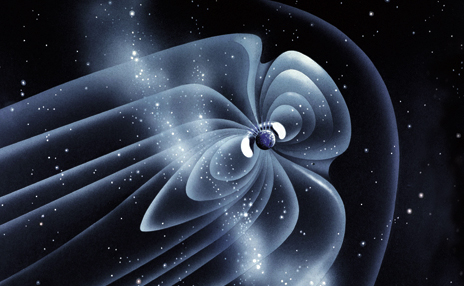About the Radiation Belts
"Most spacecraft in Earth's orbit operate partly or entirely within the radiation belts. During periods of intense space weather, the density of particles within the belts increases, making it more likely that sensitive electronics will be hit by a charged particle. Ions striking satellites can overwhelm sensors and degrade wiring and other equipment. When conditions get especially rough, satellites often switch to safe mode to protect their systems." — APL RBSP Fact Sheet
The above diagram depicts the Earth's magnetosphere—the region controlled by the Earth's magnetic field and shaped by interaction with the solar wind. The solar wind compresses the Earth's magnetic field on the day side (the side of Earth facing the sun, to the right) and drags out the magnetic field on the night side (the side away from the Sun, to the left) forming the magnetotail.
The donut-shaped, or toroidal, magnetic cavity within the magnetosphere contains the radiation belts, also known as the Van Allen belts (named after space scientist James Van Allen). These belts are made up of energetic charged particles held in place by the Earth's magnetic fields.
Illustration courtesy of NASA/Marshall SFC.
The energetic ions and electrons within the Earth's radiation belts are dangerous to both astronauts and spacecraft. The RBSP mission hopes to quantify the processes that generate the radiation belts and understand the processes that cause them to change.


